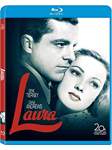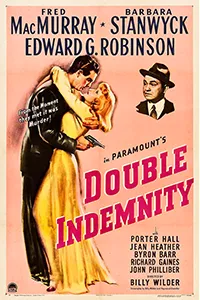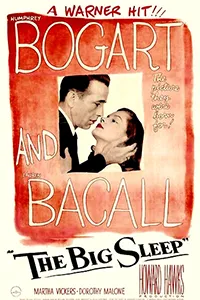LAURA
“Laura” is a 1944 classic film noir directed by Otto Preminger, known for its gripping and suspenseful plot. The film follows the investigation of the murder of Laura Hunt (Gene Tierney), a successful advertising executive, whose body is found in her apartment. Detective Mark McPherson (Dana Andrews) is assigned to the case and begins to investigate the suspects, including Laura’s fiancé Shelby Carpenter (Vincent Price), her mentor Waldo Lydecker (Clifton Webb), and her loyal maid Bessie Clary (Dorothy Adams).
As McPherson delves deeper into Laura’s life, he becomes obsessed with her and falls in love with her, despite never having met her when she was alive. His investigation leads him to believe that Shelby is the prime suspect, but as he continues to gather evidence, he discovers a shocking revelation about Laura’s murder that threatens to unravel the case and his own emotions.

Director: Otto Preminger
Year: 1944
Stars: Gene Tierney, Dana Andrew, Clifton Webb
Awards: Nominated for 5 Oscars and won one
PLOT
“Laura” is a 1944 film noir that tells the story of the murder of a young and successful advertising executive, Laura Hunt (Gene Tierney). The film opens with a shot of her portrait on the wall, while the narrator, Waldo Lydecker (Clifton Webb), delivers a eulogy that sets the tone for the rest of the film.
Detective Mark McPherson (Dana Andrews) is assigned to investigate Laura’s murder. He visits her apartment and finds himself drawn to the woman he never met, as he surveys her possessions, including a painting of her that hangs over the fireplace.
McPherson begins his investigation by interviewing Laura’s closest acquaintances, including her fiancé Shelby Carpenter (Vincent Price), who is a charming and ambitious playboy, and Waldo Lydecker, who is a famous newspaper columnist and Laura’s mentor. Lydecker proves to be a particularly intriguing character, as he seems to know everything about Laura and is fiercely possessive of her. He is also a suspect in the murder, as he has a clear motive and an unrequited love for Laura.
As the investigation continues, McPherson becomes increasingly obsessed with Laura and falls in love with her, despite the fact that she is dead. He listens to her voice on a dictaphone and studies the painting of her that hangs in her apartment. The audience is drawn into McPherson’s obsession, and his growing attachment to Laura adds an emotional dimension to the film.

The plot thickens when a woman shows up claiming to be Laura Hunt. The woman, whose real name is Diane Redfern (also played by Gene Tierney), reveals that she has been living in Mexico and has not seen Laura for years. This revelation throws McPherson’s investigation into turmoil, as he struggles to unravel the mystery of Laura’s murder.

The film reaches its climax when the real killer is finally revealed, and it is not who McPherson, or the audience, expected. The twist ending is a hallmark of film noir, and “Laura” executes it perfectly.
One of the most notable aspects of “Laura” is the way it subverts the traditional noir narrative. Instead of a femme fatale manipulating a male protagonist for her own gain, “Laura” portrays a powerful and independent woman who becomes the victim of a male-dominated world. Laura’s beauty and success in the advertising industry make her a target for men who are threatened by her, including Carpenter and Lydecker, both of whom attempt to control her.
“Laura” is a film that explores the dark side of human desire, obsession, and betrayal. The characters are richly drawn and nuanced, with hidden motives and secrets that are slowly revealed as the plot unfolds. The film is a masterpiece of the genre, and its influence can be seen in countless other films and television shows, including the popular neo-noir “Twin Peaks.”
RECEPTION
“Laura” was released in October 1944 and was met with critical acclaim, as well as commercial success. The film was praised for its intricate plot, stylish direction, and outstanding performances. It quickly became a box office hit, grossing over $2 million in the US alone.
Critics praised the film’s innovative use of flashbacks and non-linear storytelling. The New York Times critic Bosley Crowther called it a “superbly told mystery drama” and praised the film’s “deftly woven threads of character, mood, and motive.” The film was also praised for its stunning visuals, which were enhanced by the use of chiaroscuro lighting and deep focus cinematography.
“Laura” received five Academy Award nominations, winning the Oscar for Best Cinematography (Black and White) for Joseph LaShelle’s stunning work. The film’s use of deep focus photography, which allowed for multiple planes of action to be in focus at the same time, was particularly noteworthy. This technique was used to great effect in the famous portrait scene, in which Laura’s portrait is shown in sharp focus while the characters in the foreground are blurred.
The film’s score, composed by David Raksin, also received critical acclaim and has since become iconic in its own right. The haunting theme song, “Laura,” was a hit and has been covered by numerous artists over the years.
THEMES
“Laura” explores themes of power, obsession, and gender roles in a post-war America. The film challenges traditional gender roles by depicting Laura as a successful and independent woman in a male-dominated world. She is a powerful figure in the advertising industry, yet is still subject to the manipulations and control of the men in her life. This subversion of gender roles is further emphasized by the film’s portrayal of male characters who are threatened by Laura’s success and beauty.
The film also delves into the themes of obsession and desire. The character of Waldo Lydecker is a clear example of obsession, as he becomes fixated on Laura to the point of controlling her every move. His obsession is a reflection of his own insecurities and his need for control, which ultimately leads to his downfall. Similarly, the character of Detective McPherson becomes obsessed with Laura, leading him to break ethical boundaries and manipulate the evidence to protect her. The film suggests that these obsessions are destructive and ultimately lead to tragedy.

Another important theme in “Laura” is the corrupting influence of power. The characters in the film are motivated by their desire for power and control, leading them to engage in manipulative and unethical behavior. Waldo Lydecker’s power over Laura is portrayed as toxic, as he uses it to control her and prevent her from having any other relationships. Similarly, the character of Shelby Carpenter uses his power and charm to manipulate women, including Laura and Ann Treadwell. The film suggests that this quest for power ultimately leads to the characters’ downfall, and that true happiness can only be found in honest relationships.
The film’s visual style is also an important aspect of its themes. The use of shadow and light creates a moody and atmospheric tone, emphasizing the darkness and corruption that lies beneath the surface of the characters’ lives. The famous shot of Laura’s portrait is an example of the film’s visual style, as it frames the character as both an object of desire and a victim of violence. This visual motif emphasizes the themes of power and desire, as Laura becomes an object to be possessed and controlled by the men in her life.
OSCAR FOR BEST CINEMATOGRAPHY
“Laura” won the 1945 Academy Award for Best Cinematography (Black-and-White) for the stunning visuals that add an extra layer of complexity to the already intricate storyline. The film’s use of lighting and camera work is a perfect example of how cinematography can enhance the storytelling experience.
One of the most impressive aspects of the film’s cinematography is the way in which light is used to convey emotion and mood. In the opening sequence, for example, the camera lingers on a close-up of Laura’s portrait, which is bathed in a soft, glowing light that suggests her beauty and innocence. Later in the film, when Waldo is first introduced, he is shown in harsh, unflattering light that emphasizes his age and bitterness.

The use of shadows is also a prominent feature in the film’s cinematography. This is most notably demonstrated in the scene where Laura’s body is discovered. The room is shrouded in darkness, with only a sliver of light illuminating the space where her lifeless body lies. This use of light and shadow creates a sense of mystery and foreboding, adding to the overall suspense of the film.
The film’s use of camera angles is also noteworthy. For instance, the camera often frames the characters through windows, doorways, and other architectural elements. This not only adds visual interest to the shots but also creates a sense of confinement, suggesting that the characters are trapped in their own worlds.
Furthermore, the film’s cinematography plays a crucial role in the depiction of the film’s characters. In the case of Waldo, the camera frequently shoots him from a low angle, emphasizing his towering, imposing presence. By contrast, Laura is often shot from a higher angle, making her seem smaller and more vulnerable. This contrast in camera angles highlights the power dynamic between the two characters and reinforces their respective roles in the narrative.
Overall, the cinematography in Laura is a masterclass in how visuals can enhance a film’s storytelling. Through the use of light, shadows, camera angles, and framing, the film creates a unique atmosphere and brings the characters to life in a way that is both captivating and unforgettable.
POPULAR CULTURE
Since its release in 1944, “Laura” has remained a classic and influential film noir that has left a significant mark on popular culture. The film’s iconic characters, haunting music, and gripping storyline have inspired countless adaptations and homages over the years.
One of the most notable examples of “Laura” in popular culture is the song “Laura,” composed by David Raksin. The melody is often used to evoke feelings of nostalgia or longing, and has been covered by many jazz artists over the years, including Charlie Parker and Frank Sinatra. The song has also been featured in numerous films and TV shows, including the opening credits of the popular 1990s TV series “Twin Peaks.”
The character of Laura has also become a cultural touchstone, with her image and persona being referenced in various mediums. For example, in the 1960s, Laura’s distinctive portrait became a popular poster that was ubiquitous in college dorm rooms. Her image has also been used in advertising, such as in a 1999 ad campaign for Calvin Klein’s “Obsession” fragrance, which featured model Kate Moss in a Laura-esque pose.
Additionally, “Laura” has inspired numerous adaptations and remakes. In 1945, a radio adaptation of the film aired on the “Lux Radio Theater,” featuring Dana Andrews and Gene Tierney reprising their roles. In 1946, a stage adaptation premiered on Broadway, with a script by Vera Caspary, who wrote the original novel. The play ran for over 400 performances and was later adapted into a radio drama in 1950.
In 1946, “Fallen Angel,” a film directed by Otto Preminger and starring Tierney, was released. The film featured similar themes and plot elements as “Laura,” and is often considered a spiritual successor to the earlier film. In 1981, a made-for-TV movie titled “Laura” aired, featuring a cast that included Lee Remick and Richard Jaeckel.
In recent years, “Laura” has continued to inspire filmmakers and artists. In 2010, director David Lynch cited the film as an influence on his hit TV series “Twin Peaks.” The show features a similar murder mystery plotline and incorporates elements of surrealism and dream logic, which can also be seen in “Laura.”
Overall, “Laura” has become a beloved and enduring classic of the film noir genre, with its striking visuals, memorable characters, and haunting music leaving an indelible mark on popular culture.
Explore more Film Noir

A seductive woman rekindles a dangerous romance with her ex-lover in “Gilda” (1946) starring Rita Hayworth.

A gripping film noir about a seductive woman who convinces an insurance salesman to plot a murder.

This classic film noir follows private detective Philip Marlowe as he investigates a complex case involving a wealthy family.